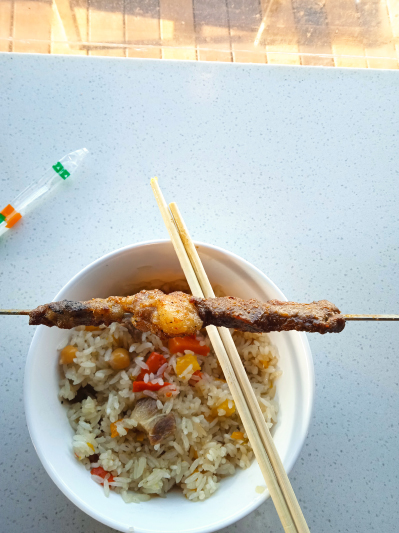| Lifestyle |
| A culinary caravan | |
|
|
 Plov, or zhuafan in standard Chinese, a dish made with rice, vegetables and a sprinkling of different spices, with a lamb skewer on top at a restaurant in Urumqi, Xinjiang Uygur Autonomous Region (YAN WEI)
Envision yourself journeying along the ancient Silk Road, where the air is filled with the harmonious melody of camel bells, the enticing aroma of sizzling spices and the rising steam from cauldrons. In this rich tapestry, merchants barter not only for silks and gems but also for the most prized currency—flavor. Fiery lamb skewers dance on open flames, hand-pulled noodles twirl like acrobats and fragrant rice dishes gleam with jewels of spice. This isn't merely a historical expedition; it's a culinary odyssey where borders dissolve, and cultures embrace through the universal language of food. In bustling Xi'an, the Silk Road's starting point, the smoky allure of yangrouchuan, lamb skewers typical for Xinjiang Uygur Autonomous Region marinated in cumin and Sichuan peppercorns, paints a bold narrative of nomadic spice blends and Chinese artistry. Lamian, or the mesmerizing spectacle of hand-pulled noodles—a dish often associated with Lanzhou, capital of Gansu Province in northwest China, shares tales of cultural exchange on its journey along the Silk Road. The Silk Road was not a one-way street; it beckoned westward with the vibrant flavors of Central Asian countries. Amidst bustling bazaars, the fragrance of plov, also known as pulao, or zhuafan in standard Chinese—a hearty rice dish teeming with succulent meat and vibrant vegetables, fills the air. Plov stands as a monument to culinary adaptation and exchange, showcasing the seamless interweaving of distant flavors with local traditions. China, not just a recipient but also a contributor, exported the iconic Peking duck, carrying the taste of Chinese mastery worldwide. The story transcends mere borrowing; it embraces transformation. A myriad of spices, echoes from distant lands, found a home in Chinese kitchens, adapting and transforming familiar dishes into vibrant creations. This culinary evolution speaks to the dynamic nature of cultural exchange, where food nourishes not just bodies but hearts. Let's venture deeper into Xinjiang's regional specialties. Beyond the fiery allure of its yangrouchuan, Xinjiang unfolds like a culinary oasis. Dapanji, a hearty stew of tender chicken, bell peppers and chilies, simmers in a cumin-infused embrace. Naan, a type of leavened bread and the lifeblood of Xinjiang cuisine, emerges from tandoor ovens. Lagman, a Uygur noodle masterpiece, boasts thick strands dancing in a savory sauce. Pair it with a few samosas, flaky golden pockets bursting with juicy fillings of spiced lamb, potato, or pumpkin—the perfect street food treat for exploring mountain villages. The samosa is also a popular snack in Pakistan, India and the Middle East with more exotic ingredients and flavor. This is just a glimpse into the kaleidoscope of flavors that Xinjiang offers. Each region, city and village has its culinary surprises, each bite a portal to rich histories and diverse cultures. So, pack your appetite for adventure and embark on your own Silk Road culinary odyssey. Embrace the bold, the spicy, the exotic—let Xinjiang's flavors guide you on an unforgettable journey through the heart of Asia, where culinary borders dissolve and the world unites on a plate. The Silk Road's legacy extends beyond a collection of dishes; it's a testament to the power of food to unite people. From lamb skewers to hand-pulled noodles, each offering tells a compelling story of trade, migration and the harmonious blending of cultures. Savoring these diverse flavors immerses us in a rich history where spices, ideas and culinary artistry transcend ancient trade routes, fostering connections through the universal language of food. As you enjoy a dish rooted in the Silk Road, remember: It's not just a meal; it's a journey. A story whispered across continents, woven into the fabric of our culinary heritage. Close your eyes, take a bite, and let the flavors transport you to the sun-drenched streets of Xi'an or the bustling bazaars of Kashgar and Samarkand. The Silk Road may be a memory, but its legacy lives on. One delicious bite at a time. The author is a Pakistani anthropologist living in Beijing Copyedited by Elsbeth van Paridon Comments to yanwei@cicgamericas.com |
|
||||||||||||||||||||||||||||
|
